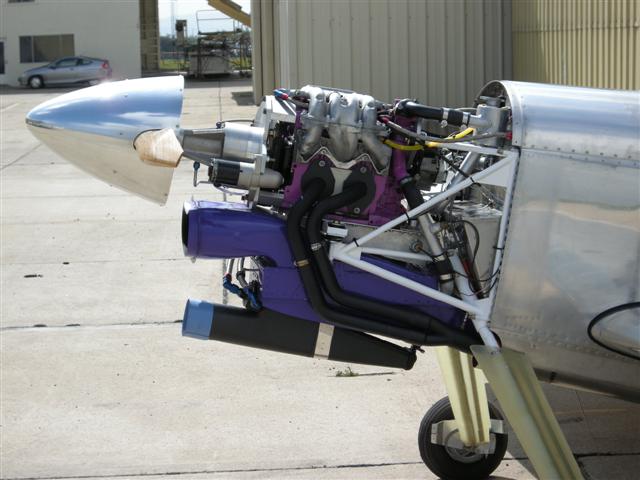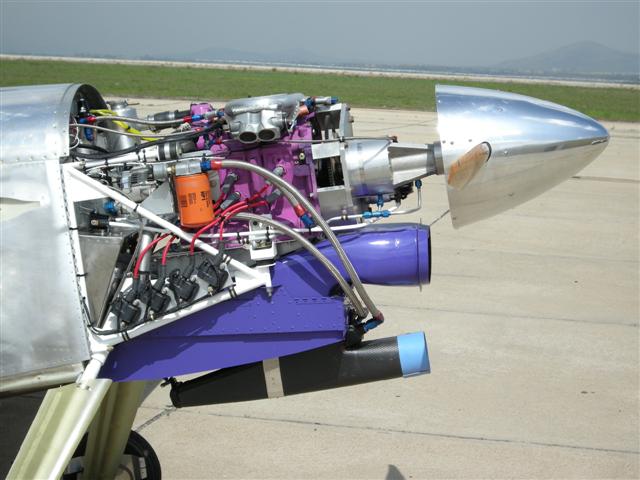|
Bill/all,
Thanks for the feedback. Most of your
comments line up with my understanding/thoughts. I didnt go into installation
details when I wrote this for a couple of reasons. One, I've said it before, and
two, many of the details now are pretty vague because my exhaust and intake
systems came together about 6 years ago. I'll recount what I
recall:
1) The engine is a Bruce Turrentine built. Turbo
housings and high compression NA rotors. No porting.
2) The exhaust is a true 2 - 1 header with
equal length primaries. I'm a little sketchy on dimensions but my recall is 1
3/4" primaries, 32" long and equal length into a Burns merge collector 2
1/2". Muffler is 4" behind the collector, 2 1/2" inlet and outlet, 28" long, 4
1/2" diameter. It's a spiral flow design, homebuilt, with a relatively large
straight tube through the middle. I dont believe it presents any significant
restriction. Internals are Inconel and it was in good shape when I had it off
the airplane a couple of weeks ago.
3) The intake starts with a modified 88 Mazda NA
lower manifold with all the excess metal cut away and port matched to the turbo
housings (blended with JB Weld). I used the first part of the upper manifold to
make the 90 degree bend over the top of the engine and from there welded on
aluminum tubes (1 1/4" primaries, 1 1/2" secondaries, about 10"
long. Plenum at the end of the tubes is small. Hard to describe so I'll try
to find a picture. The throttle body is as described previously - a hacked
Mazda tb with only 2 of the 3 original inlets.
I guess what really shocked me is how much throttle
was still remaining when I reached max power. I guess the real question is, is
my prop load limiting power output, is there some dip in the power curve and my
engine cant push the prop load "over the hump", or is it simply a matter of a
restriction in the system somewhere that is limiting the airflow? As I said
previously, I'm not too worried about it because the airplane performance is
pretty good. But who doesnt want more, especially if you suspect its there and
accessible with hopefully not too much effort?
Mike


----- Original Message -----
Sent: Saturday, October 10, 2009 11:14
PM
Subject: [FlyRotary] Re: where's the
missing power?
Mike,
There are several reasons that an engine will produce max power at "less"
than full throttle. First, and this can sometimes be hard to check, be sure
that your full throttle position doesn't rotate the throttle plate past full
open. I've seen this several times in butterfly throttle systems. If you are
using a Mazda throttle body it is likely that the wide open position is
controlled with a stop. You shouldn't have a over rotation problem with that.
The second reason, and far more common, is that the design has more intake
than it can use with the tuning or RPM that the prop limits it to. This isn't
really a problem other than indicating that with development the engine could
make more power. Often with the design constraints placed on us by a close
fitting cowling or restrictive exhaust limit the best airflow to less
than the throttle body can pass. The engine just can't "breathe" well enough
to need a larger opening. The length of the intake or exhaust can be too
long/short and the maximum amount of air that the engine can digest will be at
the 3/4 throttle area or even less. Most engines can be tuned to best
performance at a specific length inlet and the diameter is also important.
Same with the exhaust. If either system is off a significant amount it can
prevent you from making any more power past a given throttle opening. This
won't hurt the engine at all, it just shows you that some portion of the
system can be improved. If your exhaust gas temperature is correct then the
injection is working properly and you need to check the other systems. Be sure
to double check your exhaust for obstructions or a pipe collapse. We have had
too many exhaust problems lately. To put your self at ease remember this, most
modern diesels have NO throttle plate. The speed of the engine is completely
controlled by the amount of fuel injected. This helps the efficiency at
maximum throttle, but obviously there is more air than the engine can use at
low speeds. A small amount of fuel is injected, compression ignited ,and all
burns up. If all is healthy your engine is drawing all the air you can use by
half throttle. You can probably make improvements and get more power or lower
fuel burn by tuning.
Bill Jepson
-----Original Message-----
From:
Mike Wills <rv-4mike@cox.net>
To: Rotary motors in aircraft
<flyrotary@lancaironline.net>
Sent: Sat, Oct 10, 2009 8:27
pm
Subject: [FlyRotary] where's the missing power?
I noticed quite a while ago and have mentioned
several times here that my engine does not have a linear response to throttle.
It reaches its max power before it reaches fully open throttle. I havent
worried too much about this up until now because the airplane has sufficient
power as is, has slightly better performance than my previous 160HP Lyc
powered -6A, and my wood prop is actually a pretty good match for the current
power level.
But I would like to understand what's going on
here and eventually address it. I was flying yesterday, my usual boring holes
in the sky directly over the airport. Decided to investigate just a little so
leveled at 5,000 feet at full throttle. Started reducing throttle until I
noticed a slight reduction in RPM and fuel flow. Then looked down at where the
throttle was actually set and was shocked to see it slightly below half open.
I dont have a regular manifold pressure gauge, just an industrial type vacuum
gauge ( I really gotta get an MP gauge). Anyway, the vacuum gauge was
indicating 4" of vacuum.
So I suspect I am giving up a substantial amount
of HP. I think the most likely suspect is my throttle body. For a throttle
body I copied Tracy's original design. Started with a stock late 80s
Mazda TB and hacked off the third port and all of the extra stuff. The cowl in
this area is very tight and I am unable to install any sort of air filter or
any sort of bell mouth on the TB. And I'm sure the cowl's close proximity to
the TB influences airflow into it as well.
Any comments on this or ways to test it are
welcome.
Mike Wills
RV-4 N144MW
.JPG.jpg)
DSCN0088 (Small).JPG
.JPG.jpg)
DSCN0089 (Small).JPG
|